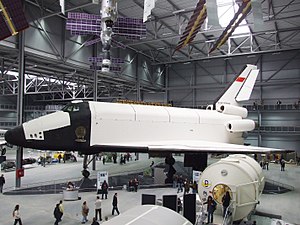OK-GLI
| OK-GLI ("Buran aerodynamic analogue") | |
|---|---|

Atmospheric Buran testbed currently on display in Technik Museum Speyer
|
|
| OV designation | BST-02 |
| Country | Soviet Union |
| Status | Owned by the Technik Museum Speyer, Germany. Serving as walk-in exhibition. |
| First flight | Taxi test 1 29 December 1984 |
| Last flight | Taxi test 9 29 December 1989 |
| No. of missions | 25 test flights |
| Time spent in space | never flew in space |
OK-GLI (Buran Analog BST-02) was a test vehicle ("Buran aerodynamic analogue") in the Buran programme. It was constructed in 1984, and was used for 25 test flights between 1985 and 1988 before being retired. It is now an exhibition at the Technik Museum Speyer in Germany.
The development of the Buran began in the late 1970s as a response to the U.S. Space Shuttle program. The construction of the orbiters began in 1980, and by 1984 the first full-scale Buran was rolled out. The first suborbital test flight of a scale-model took place as early as July 1983. As the project progressed, five additional scale-model flights were performed.
The OK-GLI (Buran Analog BST-02) test vehicle ("Buran aerodynamic analogue") was constructed in 1984. It was fitted with four AL-31 jet engines mounted at the rear (the fuel tank for the engines occupied a quarter of the cargo bay). This Buran could take off under its own power for flight tests, in contrast to the American Enterprise test vehicle, which was entirely unpowered and relied on an air launch.
The jets were used to take off from a normal landing strip, and once it reached a designated point, the engines were cut and OK-GLI glided back to land. This provided invaluable information about the handling characteristics of the Buran design, and significantly differed from the carrier plane/air drop method used by the US and the Enterprise test craft.
Nine taxi tests and twenty-five test flights of OK-GLI were performed, after which the vehicle was "worn out". All tests and flights were carried out at Baikonur.
After the program was cancelled, OK-GLI was stored at Gromov Flight Research Institute, near Moscow, where it was displayed during the annual MAKS air show.
In 2000, Analog Buran was sold to an Australian company called the Buran Space Corporation, owned by Australian astronaut Paul Scully-Power. It was disassembled and transported by ship to Sydney, Australia, via Gothenburg, Sweden — arriving on 9 February 2000 and appeared as a static tourist attraction under a large temporary structure in Darling Harbour for a few years.
...
Wikipedia
